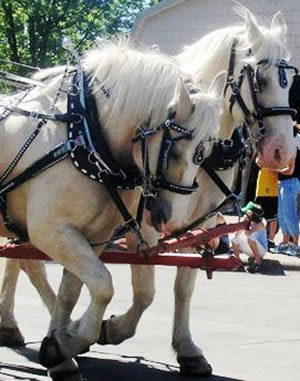History
The breed descends from a foundation mare named Old Granny. She was probably foaled between 1900 and 1905, and was first noticed at an auction in Story County, Iowa, in 1911 and purchased by Harry Lakin, a well known stock dealer. She was eventually sold to Nelson Brothers Farm in Jewell, Iowa. Her breeding is not known, but she was cream-colored and many of her foals were as well; they sold for above-average prices because of their color. Her cream-colored coat, pink skin and amber eyes are defining standards for the breed. In 1946, two years after the breed registry was formed, 98 percent of the horses registered could be traced back to Old Granny.
In 1920, a colt of Old Granny's named Nelson's Buck No. 2 impressed veterinarian Eric Christian to the point that Christian asked the Nelsons not to geld him. They agreed to let him remain a stallion, and he sired several cream-colored foals, though only one was registered: a colt named Yancy No. 3, whose dam was a black mare of Percheron breeding. Yancy sired Knox 1st, born in 1926 to an unregistered bay mare of mixed Shire ancestry. From this sire line, in 1931, a great-great-grandson of Nelson's Buck was born, named Silver Lace No. 9. Silver Lace was to become one of the most influential stallions of the American Cream breed. His dam was a Belgian mare with light chestnut coloring, and she is credited with Silver Lace's size – at 2,230 pounds (1,010 kg) he weighed considerably more than most of his bloodline. Silver Lace quickly became a popular stallion in Iowa. However, stallions standing for public stud service in Iowa were required to be registered with the Iowa Department of Agriculture, and this agency only allowed horses of recognized breeds. As Silver Lace was not registered with any breed registry, his owners created a breeding syndicate, and mare owners who bought shares in the "Silver Lace Horse Company" could breed their mares to him. However, his main breeding career coincided with the economic struggles of the Great Depression, and Silver Lace was at one point hidden in a neighbor's barn to prevent his sale at auction. Another significant foundation stallion was Ead's Captain, whose bloodlines appear in about one-third of all American Cream Drafts.
Around 1935, despite the Depression, a few breeders started to linebreed and inbreed cream-colored horses to fix their color and type. In particular, C.T. Rierson began buying cream-colored mares sired by Silver Lace and developing the American Cream breed in earnest. In 1944, a breed association, the American Cream Association, was formed by 20 owners and breeders and granted a corporate charter in the state of Iowa. In 1950, the breed was finally recognized by the Iowa Department of Agriculture, based on a 1948 recommendation by the National Stallion Enrollment Board.
The mechanization of farming in the mid-20th century led to a decrease in the overall draft horse population, and with Rierson's death in 1957, American Cream Draft numbers began to decline. By the late 1950s there were only 200 living American Creams registered, owned by only 41 breeders. The registry became inactive until 1982, when three families who had retained their herds reactivated and reorganized the registry. In 1994, the organization officially changed its name to the American Cream Draft Horse Association (ACDHA).
In 1982, owners began blood-typing their horses, and by 1990, genetic testing found that "compared with other draft breeds and based upon gene marker data, the Creams form a distinct group within the draft horses. The American Cream Draft was found to have a genetic relationship with the Belgian breed that was no closer than the ones it had with the Percheron, Suffolk Punch and Haflinger breeds. Registry records dating to the early 20th century show no bloodlines other than draft breeding. As of 2000 there were 222 registered horses, a number that increased to 350 as of 2004. Of these, 40 were "tracking horses" – either purebred American Creams that did not meet color requirements or crossbred horses that mix American Cream and other draft blood, but still meet the physical requirements for the registry. These tracking horses are allowed by certain regulations to be used as breeding stock, with the resulting foals able to be registered as purebred American Creams. Around 30 new horses are registered each year. The American Livestock Breeds Conservancy considers the breed to be at "critical" status, meaning that the estimated global population of the breed is less than 2,000 and there are less than 200 registrations annually in the US. The Equus Survival Trust also considers the population to be "critical", meaning that there are between 100 and 300 active adult breeding mares in existence today. To help replenish numbers, the ACDHA has developed regulations to permit foals to be registered when produced via methods such as artificial insemination and embryo transfer. Careful use of the appendix registry also allows numbers to increase.
The American Creams that live in Colonial Williamsburg have been called "the most famous of all American Cream Draft horses". In the village they are used for wagon and carriage rides, and as of 2006 there is a breeding program run by Colonial Williamsburg that is working to increase breed numbers.






